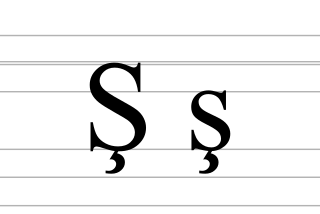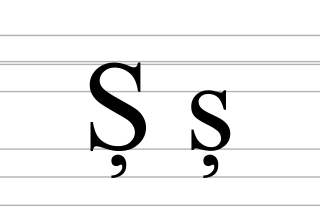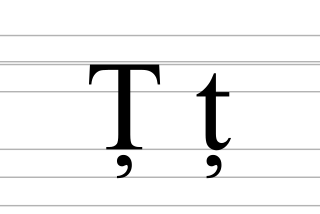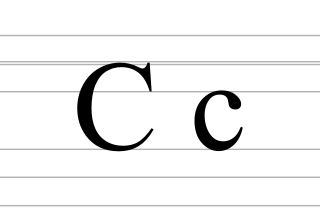
A diacritic is a glyph added to a letter or to a basic glyph. The term derives from the Ancient Greek διακριτικός, from διακρίνω. The word diacritic is a noun, though it is sometimes used in an attributive sense, whereas diacritical is only an adjective. Some diacritics, such as the acute ⟨ó⟩, grave ⟨ò⟩, and circumflex ⟨ô⟩, are often called accents. Diacritics may appear above or below a letter or in some other position such as within the letter or between two letters.

QWERTY is a keyboard layout for Latin-script alphabets. The name comes from the order of the first six keys on the top letter row of the keyboard: QWERTY. The QWERTY design is based on a layout included in the Sholes and Glidden typewriter sold via E. Remington and Sons from 1874. QWERTY became popular with the success of the Remington No. 2 of 1878 and remains in ubiquitous use.
A cedilla, or cedille, is a hook or tail added under certain letters as a diacritical mark to modify their pronunciation. In Catalan, French, and Portuguese it is used only under the letter c, and the entire letter is called, respectively, c trencada, c cédille, and c cedilhado. It is used to mark vowel nasalization in many languages of Sub-Saharan Africa, including Vute from Cameroon.

Ç or ç (C-cedilla) is a Latin script letter used in the Albanian, Azerbaijani, Manx, Tatar, Turkish, Turkmen, Kurdish, Kazakh, and Romance alphabets. Romance languages that use this letter include Catalan, French, Portuguese, and Occitan, as a variant of the letter C with a cedilla. It is also occasionally used in Crimean Tatar and in Tajik to represent the sound. It is rarely used in Balinese, usually only in the word "Çaka" during Nyepi, one of the Balinese Hinduism holidays. It is often retained in the spelling of loanwords from any of these languages in English, Basque, Dutch, Spanish and other languages using the Latin alphabet.
A caron is a diacritic mark placed over certain letters in the orthography of some languages, to indicate a change of the related letter's pronunciation.
ISO/IEC 8859-2:1999, Information technology — 8-bit single-byte coded graphic character sets — Part 2: Latin alphabet No. 2, is part of the ISO/IEC 8859 series of ASCII-based standard character encodings, first edition published in 1987. It is informally referred to as "Latin-2". It is generally intended for Central or "Eastern European" languages that are written in the Latin script. Note that ISO/IEC 8859-2 is very different from code page 852 which is also referred to as "Latin-2" in Czech and Slovak regions. Almost half the use of the encoding is for Polish, and it's the main legacy encoding for Polish, while virtually all use of it has been replaced by UTF-8.

S-cedilla is a letter used in some of the Turkic languages. It occurs in the Azerbaijani, Gagauz, Turkish, and Turkmen alphabets. It is also planned to be in the Latin-based Kazakh alphabet. It is used in Brahui, Chechen, Crimean Tatar, Kurdish, and Tatar as well, when they are written in the Latin alphabet.

A digraph or digram is a pair of characters used in the orthography of a language to write either a single phoneme, or a sequence of phonemes that does not correspond to the normal values of the two characters combined.

EzhEZH, also called the "tailed z", is a letter, notable for its use in the International Phonetic Alphabet (IPA) to represent the voiced postalveolar fricative consonant. For example, the pronunciation of "si" in vision and precision, or the ⟨s⟩ in treasure. See also the letter ⟨Ž⟩ as used in many Slavic languages, the letter ⟨Ż⟩ as used in Kashubian, the Persian alphabet letter ⟨ژ⟩, the Cyrillic letter ⟨Ж⟩, the Devanagari letter (झ़) and the Esperanto letter ⟨Ĵ⟩.

The Romanian alphabet is a variant of the Latin alphabet used for writing the Romanian language. It is a modification of the classical Latin alphabet and consists of 31 letters, five of which have been modified from their Latin originals for the phonetic requirements of the language.

Tse, also known as Ce, is a letter of the Cyrillic script.

S-comma is a letter which is part of the Romanian alphabet, used to represent the sound, the voiceless postalveolar fricative. S-comma consists of an s with a diacritical comma underneath it, and is distinct from s-cedilla.
The Common Turkic alphabet is a project of a single Latin alphabet for all Turkic languages based on a slightly modified Turkish alphabet, with 34 letters recognised by the Organization of Turkic States. Its letters are as follows:

T-comma is a letter which consists of a t with a diacritical comma underneath it, and is distinct from t-cedilla. It is part of the Romanian alphabet, used to represent the Romanian language sound, the voiceless alveolar affricate. The letter is also a part of the Finno-Ugric Livonian language alphabet, representing the sound.
The modern Gagauz alphabet is a 31-letter Latin-based alphabet modelled on the Turkish alphabet and Azerbaijani. It is used to write the Gagauz language.

C, or c, is the third letter of the Latin alphabet, used in the modern English alphabet, the alphabets of other western European languages and others worldwide. Its name in English is cee, plural cees.

D-comma is a letter that was part of the Romanian alphabet to represent the sound or if it was derived from a Latin d. It was the equivalent of the Cyrillic letters З and Ѕ.
Latin Extended-B is the fourth block (0180-024F) of the Unicode Standard. It has been included since version 1.0, where it was only allocated to the code points 0180-01FF and contained 113 characters. During unification with ISO 10646 for version 1.1, the block range was extended by 80 code points and another 35 characters were assigned. In version 3.0 and later, the last 60 available code points in the block were assigned. Its block name in Unicode 1.0 was Extended Latin.













